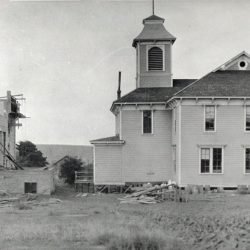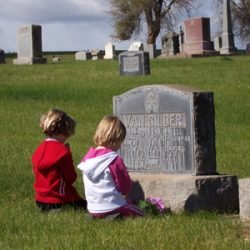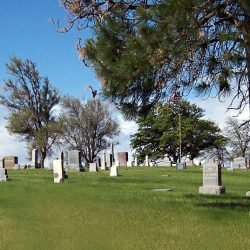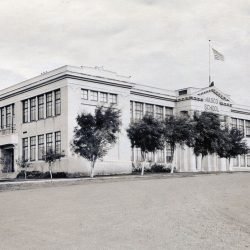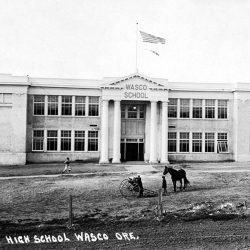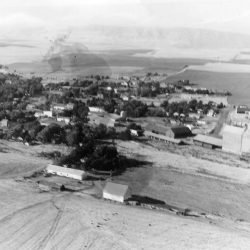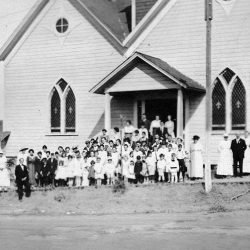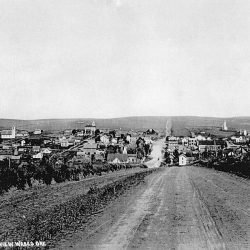Wasco bears the name of Sherman County’s parent county and an eastern Chinook tribe called Wascopum or Wascopam on the S side of the Columbia River near The Dalles. The name Wasco comes from a native word, wacqlo, a cup or small bowl of horn, reference to a cup-shaped rock a short distance from the main village, and from the tribal name, Galasq’o – those that have the cup. The Wasco tribe belonged to the upstream branch of the Chinookan linguistic stock, their closest relatives being the Wishram on the opposite side of the Columbia River. Fishing stations were located up and down the river. The 1910 census reported 242 Wasco Indians; the US Office of Indian Affairs counted 227 in 1937.
In 1880, Wilson M. Barnett, pioneer merchant and banker, had a little store on his Spanish Hollow homestead N of town near Eaton’s which he moved to Dunlap’s ground at Wasco in 1882.
The town was formed at the intersection of four homestead corners existing in 1882: McPherson’s on the SE, Biggs on the SW, Armsworthy on the NE and Dunlap on the NW. The original town was largely on Dunlap’s tract and he platted the town, 16 July 1883 when the town had the first church in the county and blacksmith and machine shops. McPherson and Armsworthy did not grant rights-of-way for roads while Biggs and Dunlap did. As the town grew it expanded: Dunlap’s 1st Addition, Dunlap’s 2nd Addition, Armsworthy’s Addition, McPherson’s 1st Addition, McPherson’s 2nd Addition, Biggs’ 1st and 2nd Additions, and Fairview Addition.
In 1898, Wasco was thriving with a doubled population. The town, serving a wide area of farmers and stockmen, comprised Columbia Southern Railway Company employees, the Oskaloosa Hotel, Wasco Hotel, Farmers Co-op Warehouse Association, wagon maker, broom manufacturer, general merchandise stores, three immense warehouses, milliners, ministers, laborers, attorney-at-law, teachers, Sherman County Bank, Union Lumber Company, Wasco Lumber Company, blacksmiths, Columbia Commercial Company wheat buyers, Columbia Southern Telegraph Company, Crosfield’s Oregon Trading Company, Delmonico Restaurant, cigar and tobacco shop, physicians and surgeons, harness makers, harness and saddle shop, well drillers, confectionery, postmistress and assistant, livery stable and feed dealer, contractor, dressmaker, bowling alley, billiard hall, barber, carpenters, The Wasco News, a boot and shoemaker, realtors, plow manufacturer, drugstore, insurance agent, dentist, meat market, undertaking parlor, watchmaker/jeweler, painter and the Wasco Cornet Band.
A fire in 1903 or ‘04 destroyed Oregon Trading Company, the Opera House and John Venable’s house. On 16 July 1904, the city voted a $12,000 bond to complete fire protection and sewerage systems. ~History of Central Oregon, 1905; J.A. Elder, Wasco News, 27 July 1928; McArthur, OGN; French; Due & Rush; Due & French; Corning; ASC 1913; ASC 1934; USGS Wasco Quadrangle; L.A. McArthur, Oregon Geographic Names, 1944 & OHS Quarterly, XLVII-1, p.97, 1946; Smithsonian Institution, Bureau of American Ethnology, Bulletin 145; SC:FTR 3-2, 18-2, 21-1; Bea Richelderfer; Gertrude, Ivalou & Esther Peugh; Wasco and Sherman County Directory 1898; Douthit, The Dalles Times-Mountaineer, Resources of Wasco and Sherman Counties, 1898.
Jesse Eaton was Wasco’s first postmaster at the head of Spanish Hollow 1.5 miles N of town, established in 1870, at Eaton’s post stop on the stage line. The name was made officially Wasco and the post office moved to the Wilson M. Barnett store on his homestead N of town near Eaton’s place, and then to his store in Wasco in 1888.
In 1898 the postmistress was Mrs. Mary Jory who settled on 160 acres. In 1900 the post office was moved into a building where the City Hall and library are located and William Henrichs was postmaster. Others serving in this capacity include: Clark Dunlap 1902, W.E. Tate 1903, and Harold White 1935, then the office was moved into the former Barnett Bank. In 1962 it was moved into the O’Meara building where it was in 1982. Harold Engberg was named postmaster in 1965, followed by John Annis in 1977 and Doris Nisbet in 1980. In 1982 a post office in Wasco had served the public for 100 years. ~Wasco and Sherman County Directory 1898; Bea Richelderfer; SCJ, 25 March 1982.
In 1897 Wasco was the first Sherman County town to be incorporated and hold elections. The town suffered a disastrous fire in 1903. At one time Wasco had a weekly newspaper, two hotels, one school, two banks, two flour mills, shops and general stores, four implement dealers, 1 millinery shop, a lumber yard, brick yard, two hospitals, dentist, doctor, an opera house, two saloons and two barber shops.
~ Sherman County Place Names, Streets and Roads, 3rd Edition, 2009, compiled by Sherry (Woods) Kaseberg.
Mr. McKee had his own formula at McKee’s Drug Store in Wasco – and made Magic Lotion which Wasco women and girls used to keep their hands soft. – Gladys (Morrow) Laidlaw (1901-2000)

